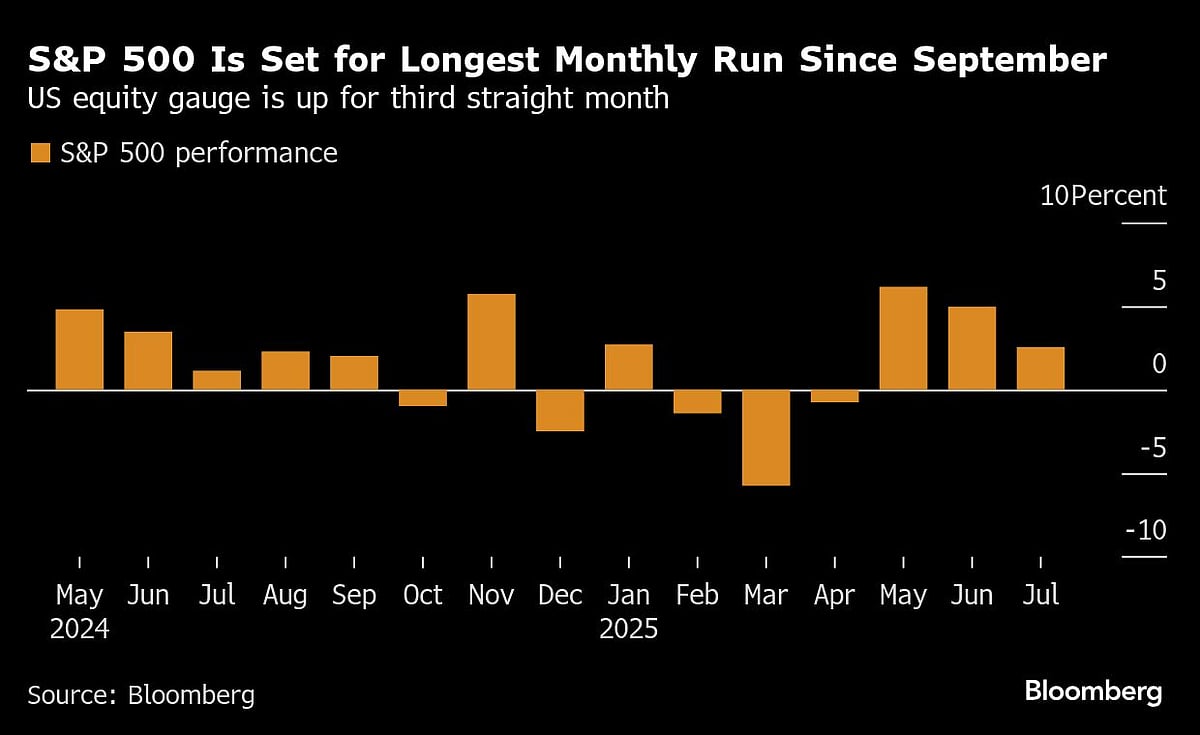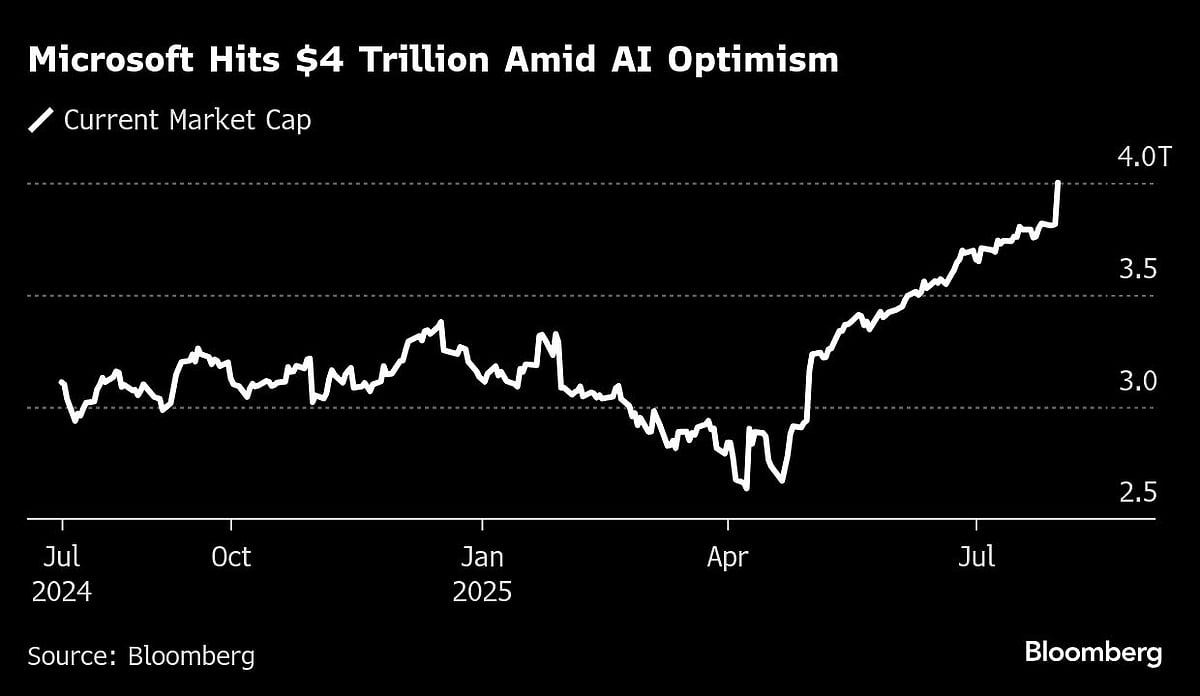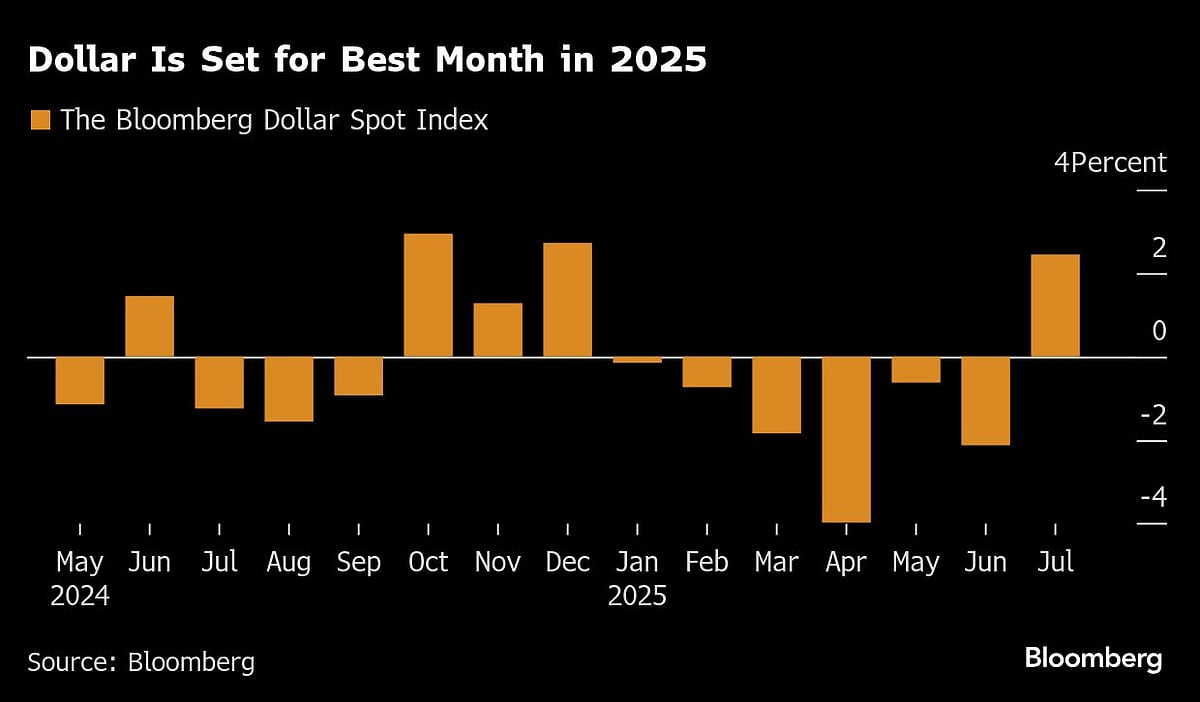‘Mag Seven’ Hit All-Time Highs as Meta Soars 12%: Markets Wrap
Equities extended their July advance, with the S&P 500 set for its longest streak of monthly gains since September.

A rally in big tech drove stocks toward record highs, with traders gearing up for jobs data that’s forecast to show moderation in hiring and help make the case for Federal Reserve rate cuts. Bond yields fell.
As another banner month for equities draws to a close, S&P 500 rose as solid results from a pair of megacaps fueled optimism about artificial-intelligence. Microsoft Corp. briefly topped $4 trillion. Meta Platforms Inc. soared 12%. A gauge of the “Magnificent Seven” tech giants hit all-time highs. Apple Inc. and Amazon.com Inc.’s results are due after the close.
Treasury 10-year yields fell four basis points to 4.33%. The dollar edged up at the end of its best month in 2025. The Mexican peso climbed as President Donald Trump said he extended current tariff rates for 90 days. The yen slid as comments from Bank of Japan Governor Kazuo Ueda were seen as less hawkish than expected.
The Fed’s preferred measure of underlying inflation accelerated in June to one of the fastest paces this year while consumer spending barely rose, underscoring the dueling forces dividing policymakers over the path of rates.
Still, bullish appetites have remained largely steady this week thanks to the AI-driven earnings story, after a spate of economic data. Friday’s jobs report will offer investors fresh insight on the economic and monetary outlook.
“Rate cuts are nice, but they are not necessary for US stocks to continue higher,” said Bret Kenwell at eToro. “Instead, earnings continue to drive the narrative — and today that narrative is focused on Microsoft and Meta’s results.”

The core personal consumption expenditures price index rose 0.3% from May. It advanced 2.8% on an annual basis, a pickup from June 2024 that underscores limited progress on taming inflation in the past year. The data also showed inflation-adjusted consumer spending edged up last month after declining in May.
“Inflation remains sticky and justifies the Fed’s decision to keep rates unchanged at Wednesday’s meeting,” said Clark Bellin at Bellwether Wealth. “The stock market doesn’t need rate cuts in order to move higher and has already posted strong gains so far this year without any rate cuts.”
As with so many things in the economy, the situation is very fluid and we have yet to see the full impact of tariffs flowing through to inflation, according to Chris Zaccarelli at Northlight Asset Management.
“We are priced for perfection as they say, and that is a risk, but one that will likely be ignored by the market as long as corporate profits are still growing,” he said.

Separate data Thursday showed initial applications for unemployment insurance were little changed last week. Another report showed labor cost growth rose 3.6% from a year ago, matching the lowest since 2021, reassuring Fed officials that the job market isn’t a source of inflationary pressure.
The market’s attention will soon turn to Friday’s jobs report for July, which is forecast to show companies are becoming more deliberate in their hiring. Employment likely moderated after a June increase, while the unemployment rate is seen ticking up to 4.2%.
President Trump resumed his criticism of Fed Chair Jerome Powell after the central bank declined to cut interest rates, ending a short-lived détente.
Trump’s comments come after Fed officials left interest rates unchanged on Wednesday but downgraded their view of the US economy, signaling that policymakers could be edging closer to lowering borrowing costs.

Corporate Highlights:
Microsoft Corp. plans to spend over $30 billion in the current quarter to build out the data centers powering artificial-intelligence services. Its results suggested the firm, perhaps the most prodigious spender of the AI age, is starting to see a return in the form of rising sales.
Meta Platforms Inc. is taking advantage of its lucrative advertising business and stepping up spending next year, with executives saying now is the time to seize on investment opportunities in artificial intelligence.
Alphabet Inc.’s Google lost its appeal of a judge’s order requiring an overhaul of the technology giant’s app store policies in an antitrust case filed by Fortnite-maker Epic Games Inc.
Qualcomm Inc., the biggest maker of chips that run smartphones, reported lackluster growth in that market, fueling concerns that tariffs will take a toll on the industry.
Arm Holdings Plc, which provides the most widely used technology in computing chips, gave a lower-than-expected profit forecast for the current period after ramping up spending on new products.
Mastercard Inc. reported earnings that topped analysts’ estimates and gave a more optimistic forecast for this year’s revenue on continued momentum in consumer spending.
Ford Motor Co. said its profit this year is poised for a sharp drop on the growing fallout from President Donald Trump’s tariffs, underscoring the dramatic policy shifts in Washington that are upending the auto industry.
Moderna Inc. is cutting about 10% of its workforce, part of an effort by the struggling biotech company to reduce spending as sales of its Covid vaccine decline.
Bristol Myers Squibb Co. slid as investors questioned whether the drugmaker has done enough to spur future sales growth in the face of an aging drug portfolio, even after lifting its full-year guidance and beating Wall Street’s quarterly sales and profit estimates.
AbbVie Inc. raised its full-year profit forecast, thanks to booming sales from a pair of newer immunology drugs and a promising start for the company’s new Parkinson’s treatment.
A trial of Eli Lilly & Co.’s blockbuster diabetes drug Mounjaro fell short of expectations that it would do a better job of preventing heart attacks and strokes than its older medicine Trulicity.
Biogen Inc. raised its full-year financial guidance as growing sales of its Alzheimer’s drug helped the biotech company beat Wall Street’s expectations.
CVS Health Corp. raised its 2025 profit guidance on strong results in its health insurance and pharmacy businesses, an encouraging sign after a spate of missteps by rival insurers.
Cigna Group reported second-quarter profit slightly ahead of analysts’ expectations and affirmed its outlook for the year, a sign of stability in a turbulent time for the broader health insurance sector.
Robinhood Markets Inc. posted second-quarter revenue that beat Wall Street estimates, boosted by strength in cryptocurrency trading.
Lyft Inc. has gained the necessary regulatory clearance to complete its acquisition of European taxi app Freenow, setting the stage for the US rideshare company to expand its operations into Europe.
Some of the main moves in markets:
The S&P 500 rose 0.7% as of 10:29 a.m. New York time
The Nasdaq 100 rose 0.7%
The Dow Jones Industrial Average rose 0.1%
The Stoxx Europe 600 fell 0.6%
The MSCI World Index rose 0.3%
Microsoft rose 4.8%
Meta rose 12%
Currencies
The Bloomberg Dollar Spot Index rose 0.1%
The euro rose 0.2% to $1.1426
The British pound fell 0.2% to $1.3212
The Japanese yen fell 0.7% to 150.56 per dollar
Cryptocurrencies
Bitcoin rose 0.7% to $118,011.65
Ether rose 0.2% to $3,775.29
Bonds
The yield on 10-year Treasuries declined two basis points to 4.35%
Germany’s 10-year yield declined one basis point to 2.70%
Britain’s 10-year yield declined four basis points to 4.57%
The yield on 2-year Treasuries declined one basis point to 3.93%
The yield on 30-year Treasuries declined two basis points to 4.88%
Commodities
West Texas Intermediate crude fell 0.3% to $69.78 a barrel
Spot gold rose 0.7% to $3,296.99 an ounce

